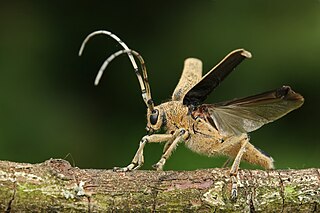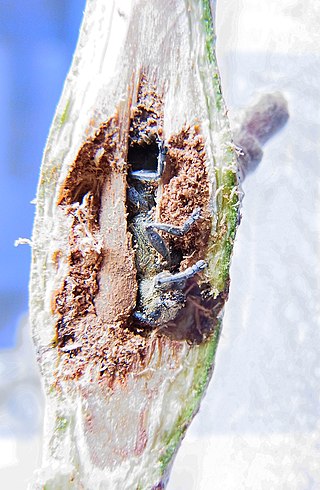Dalla octomaculata, the eight-spotted skipper or light-spotted skipper, is a species of butterfly in the family Hesperiidae, in the subfamily Heteropterinae, which are sometimes called skipperlings. It is found in Costa Rica and Panama.
Levenhookia octomaculata, the dotted stylewort or eight-spotted stylewort, is a dicotyledonous plant that belongs to the genus Levenhookia. The specific epithet octomaculata refers to the eight red dots this plant produces on each flower. It is an ephemeral annual that grows from 4–10 centimetres (1.6–3.9 in) tall with a simple or branched stem. There are very few leaves that are obovate to spathulate and mostly around the base of the stem. Scapes are umbellate and dark-coloured. Flowers are bright pink with white throats and two red dots borne on each petal. L. octomaculata blooms from September to October in its native range. It is endemic to Western Australia. Its habitat has been reported as being sandy soils in open Acacia acuminata or Eucalyptus wandoo forests in compact colonies. Because this species is known from several populations that are not believed to be under immediate threat but are poorly known, this species has been declared a priority three species, which means it is under consideration for rare status but more information must be gathered first.

Alypia octomaculata, the eight-spotted forester, is a moth of the family Noctuidae first described by Johan Christian Fabricius in 1775. It is native to Canada, but can be found today throughout Northern America, ranging between Nova Scotia to Florida and South Dakota to Texas. Their habitats being rather specific, they make home where wooded areas meet open fields.

Saperda carcharias is a species of longhorn beetle.

Saperda is a genus of flat-faced longhorn beetles belonging to the family Cerambycidae, subfamily Lamiinae. The genus was erected by Johan Christian Fabricius in 1775.

Saperdini is a tribe of longhorn beetles of the subfamily Lamiinae.
Glenea octomaculata is a species of beetle in the family Cerambycidae. It was described by Per Olof Christopher Aurivillius in 1927.

Saperda calcarata, the poplar borer, is a species of beetle in the family Cerambycidae. It was described by Thomas Say in 1824. It is known from Canada and the United States. It contains the varietas Saperda calcarata var. adspersa.
Saperda inornata is a species of beetle in the family Cerambycidae. It was described by Thomas Say in 1824. It is known from Canada and the United States. It feeds on Populus tremuloides.

Saperda candida, the roundheaded appletree borer, is a species of beetle in the family Cerambycidae. It was described by Johan Christian Fabricius in 1787. It is known from Canada and the United States. It contains the varietas Saperda candida var. bipunctata.
Saperda horni is a species of beetle in the family Cerambycidae. It was described by Joutel in 1902. It is known from Canada and the United States. The species name is often misspelled as hornii.
Saperda interrupta is a species of beetle in the family Cerambycidae. It was described by Gebler in 1825. It is known from China, Russia, Siberia, Korea and Japan. It is associated with coniferous plantations, and infests species of fir, pine, spruce and other conifers.
Saperda lateralis is a species of beetle in the family Cerambycidae. It was described by Johan Christian Fabricius in 1775. It is known from Canada and the United States.

Saperda perforata is a species of beetle in the family Cerambycidae. It was described by Pallas in 1773, originally under the genus Cerambyx. It has a wide distribution in Europe. It feeds on Populus nigra, Populus alba, and Populus tremula. It is preyed upon by the parasitoid wasp Xorides indicatorius.

Saperda populnea, the small poplar borer, is a species of beetle in the family Cerambycidae which forms woody galls on twigs of poplars and willows. It was described by Carl Linnaeus in 1758.

Saperda quercus is a species of beetle in the family Cerambycidae. It was described by Charpentier in 1825. It is known from Turkey, Romania, Bosnia and Herzegovina, Jordan, Serbia, Bulgaria, Greece, Syria, and possibly Hungary. It feeds on Quercus coccifera.

Saperda scalaris is a species of beetle in the family Cerambycidae. It was described by Carl Linnaeus in 1758, originally under the genus Cerambyx. It has a wide distribution in Europe and Asia. It is preyed upon by parasitoid wasp species including Xorides praecatorius and Helcon angustator.

The elm borer is a species of beetle in the family Cerambycidae. It was described by Guillaume-Antoine Olivier in 1795. It is known from Canada and the United States. It feeds on Ulmus rubra and Ulmus americana. It acts as a vector for the fungus Ophiostoma ulmi, and as a host for the parasitoid wasp Cenocoelius saperdae.

The eight-spotted miner bee is a species of miner bee in the family Andrenidae. Another common name for this species is the eight-spotted perdita. It is found in North America.
Stelidota octomaculata is a species of sap-feeding beetle in the family Nitidulidae. It is endemic to North America.











